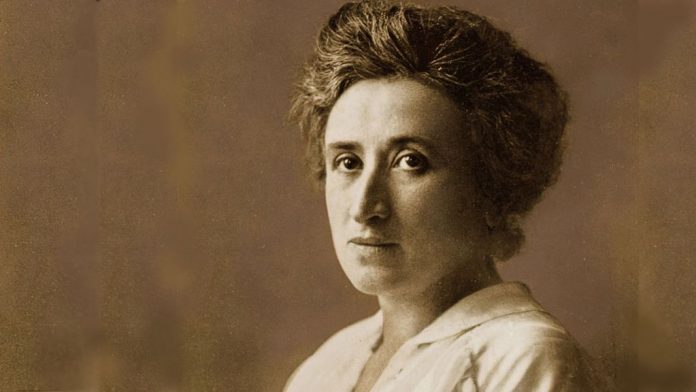Rosa Luxemburg a Short Biography
Rosa Luxemburg (1871-1919) was born in Poland , a country that was then divided between Russia , Austria and Prussia ( Germany’s largest part of Germany ). Rosa’s duffel bag through life was not the easiest to carry. She was a woman, a Jew and a socialist. In addition, she limped severely.
The persecution of Jews in Warsaw, where Rosa moved as a three-year-old, was periodically very intense. At the age of twelve, she experienced a terrible attack on Jewish residents. The impression of the bullying’s rawness gave her but for life, among other things in a well-hidden fear of crowds. At school she did well. In 14 subjects she received the grade A.
After graduating, Rosa Luxemburg became a member of an illegal socialist group. She moved to Switzerland in 1889 to escape anti-Semitism and continue her studies. There she met and began a relationship with the Russian revolutionary Leo Jogiches.
In 1897, Rosa became a doctor of law. Her work was raised to the skies.
Leo and Rosa forged plans to emigrate to Germany, a country where they could better realize their political ideals. To facilitate the move, Rosa entered into a sham marriage with a German mechanic she did not know at all.
In Germany, it was election year. Rosa quickly studied German politics and then entered the election work as an agitator (political speaker). She quickly became a central figure in the Social Democratic Party.
In 1898, Rosa published the article Social Reforms or Revolution? , which received much attention. Rosa Luxemburg thus became internationally known.
In 1904 she was imprisoned for a short time as punishment for insulting Emperor Wilhelm in a speech.
Rosas also criticized the Russian revolutionary Vladimir Lenin . The sharpest salvo was directed at Lenin’s thoughts of absolute central rule. Of course, Rosa Luxemburg wanted a revolution, but not in Lenin’s way, with armed rebellion. Luxembourg wanted the proletariat (workers) to raise their consciousness, not their rifles.
The Russian revolutionary attempt in 1905 raised hopes for new political opportunities for Poland. Rosa moved there and stayed there for a while. In a short time, the Luxembourg party grew from 400 members to 30,000.
In 1906, Rosa was arrested by the tsar’s police. She was soon released and traveled to Finland . There she met Lenin. Though reluctantly, she realized the power of Lenin’s Bolsheviks. Back in Germany, she came to push the issue of revolution much harder than the German Social Democrats wanted to do. She still saw mass strikes as the way forward.
A couple of Rosa Luxemburg’s speeches led to prosecution. The day before one of her trials, on June 28, 1914, the Austrian Archduke Franz Ferdinand was assassinated in Sarajevo, which was the prelude to the First World War .
In protest against the Social Democrats’ willingness to cooperate with the ruling regime during the war, Rosa Luxemburg and Karl Liebknecht formed the so-called Spartacus Confederation, which advocated peace and more radical socialist ideas. The aim was to remove the military from power, socialize important industries and create a German Soviet republic.
With the exception of a few short periods of freedom, Rosa was imprisoned during the war until 1918. During a free period in 1916, she and other members of the Spartacus League distributed leaflets with messages against the war and the government. The action ended again with a prison for Rosa.
The Spartacus League was active during the German so-called November Revolution of 1918 . The November Revolution began as a mutiny within the German navy and then spread to the army, eventually leading to a workers’ uprising. It was a turbulent time in German history : a civil war was imminent, the emperor abdicated, the Social Democratic government withdrew from World War I, and clashes between government troops and workers took place in several parts of the country.
On December 30, 1918, the Spartacus League, along with other revolutionary groups, was transformed into the KPD, the German Communist Party. Pink Luxembourg was there.
On January 5, 1919, the so-called Spartacus uprising broke out in Berlin. Thousands of workers took to the streets and occupied some buildings. On the morning of January 6, the Communist Party, among other things, formed a revolutionary committee that proclaimed that they had taken over power in the country. Army task forces retaliated and killed the rebels within days.
Rosa Luxemburg Death Cause
On January 15, 1919, Rosa – who was hiding in an apartment – was tracked down by armed militiamen. On the way to the prison, her guard did justice on her own. They shot her in the head and threw her body into the river Spree.
The November Revolution formally ended on August 11, 1919, when a new German constitution was signed and the Weimar Republic was established.
Pink Luxembourg has been seen as a revolutionary socialist alternative to reformist social democracy and dictatorial Soviet communism. Since her death, many Social Democrats, Trotskyists, Leninists and anarchists have carried on her legacy by emphasizing various aspects of her political views.
Most of what was published by Rosa Luxemburg was burned by the Nazis during the book bonfire in Nazi Germany in 1933.
Thank you for reading, please share the article to give us credit!
Also Read: Berlin Wall Interesting Facts

